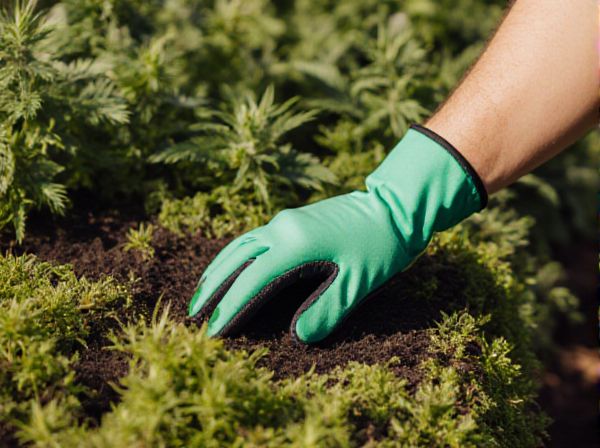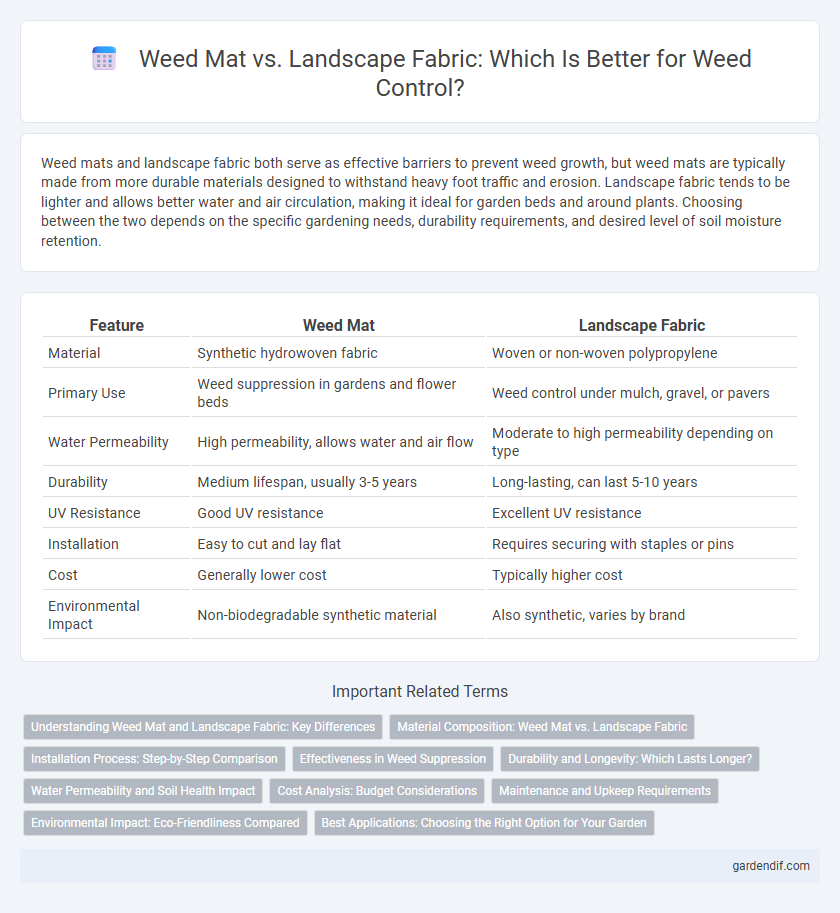
Weed mat vs landscape fabric Illustration
Weed mats and landscape fabric both serve as effective barriers to prevent weed growth, but weed mats are typically made from more durable materials designed to withstand heavy foot traffic and erosion. Landscape fabric tends to be lighter and allows better water and air circulation, making it ideal for garden beds and around plants. Choosing between the two depends on the specific gardening needs, durability requirements, and desired level of soil moisture retention.
Table of Comparison
| Feature | Weed Mat | Landscape Fabric |
|---|---|---|
| Material | Synthetic hydrowoven fabric | Woven or non-woven polypropylene |
| Primary Use | Weed suppression in gardens and flower beds | Weed control under mulch, gravel, or pavers |
| Water Permeability | High permeability, allows water and air flow | Moderate to high permeability depending on type |
| Durability | Medium lifespan, usually 3-5 years | Long-lasting, can last 5-10 years |
| UV Resistance | Good UV resistance | Excellent UV resistance |
| Installation | Easy to cut and lay flat | Requires securing with staples or pins |
| Cost | Generally lower cost | Typically higher cost |
| Environmental Impact | Non-biodegradable synthetic material | Also synthetic, varies by brand |
Understanding Weed Mat and Landscape Fabric: Key Differences
Weed mats, typically made from natural fibers like jute or coir, allow for better water penetration and biodegrade over time, making them ideal for organic gardening. Landscape fabric, composed of synthetic materials such as polypropylene, offers superior durability and long-term weed suppression but may restrict soil aeration. Choosing between weed mat and landscape fabric depends on balancing environmental impact, longevity, and maintenance needs for effective weed control.
Material Composition: Weed Mat vs. Landscape Fabric
Weed mats are typically made from natural fibers such as jute or coir, allowing for better biodegradability and soil integration, whereas landscape fabrics are primarily composed of synthetic materials like woven polypropylene or polyester designed for durability and long-term use. The natural composition of weed mats encourages water permeability and microbial activity, benefiting plant health, while landscape fabrics provide stronger weed suppression by blocking sunlight and limiting weed growth. Material choice depends on the balance between environmental impact and the desired longevity of weed control in garden or landscaping projects.
Installation Process: Step-by-Step Comparison
Weed mats typically require straightforward installation by spreading the fabric over the soil and securing with landscape staples, ensuring full ground coverage to block weed growth. Landscape fabric installation involves similar steps but often demands overlapping edges to prevent weed penetration and may require additional anchoring for durability. Both materials benefit from layering mulch on top to enhance effectiveness and prolong fabric lifespan.
Effectiveness in Weed Suppression
Weed mats provide superior weed suppression by creating a denser barrier that blocks sunlight and prevents weed growth more effectively than landscape fabric. Unlike typical landscape fabric, weed mats are designed with higher durability and reduced permeability, ensuring longer-lasting protection against invasive weeds. Their tightly woven structure minimizes soil exposure, significantly reducing weed germination and maintenance efforts in garden beds.
Durability and Longevity: Which Lasts Longer?
Weed mat generally offers higher durability and longer longevity compared to standard landscape fabric due to its thicker, woven polypropylene construction that resists tearing and UV degradation. Landscape fabric, while effective for short-term weed prevention, tends to break down faster under prolonged sun exposure and heavy foot traffic. Choosing a premium weed mat can extend weed control effectiveness for up to 10 years versus 3 to 5 years for typical landscape fabric.
Water Permeability and Soil Health Impact
Weed mats typically offer higher water permeability compared to landscape fabric, allowing better water infiltration and reducing surface runoff. This enhanced permeability supports healthier soil ecosystems by maintaining natural moisture levels and promoting beneficial microbial activity. In contrast, some landscape fabrics can impede water flow, potentially leading to soil compaction and reduced nutrient availability over time.
Cost Analysis: Budget Considerations
Weed mats generally cost less upfront than landscape fabric, making them a more budget-friendly option for large-scale gardening projects. While landscape fabric can be more durable and reusable, its initial price is higher, which may impact short-term budget considerations. Factoring in the longevity and effectiveness of both materials helps determine the most cost-efficient investment for weed control.
Maintenance and Upkeep Requirements
Weed mats offer superior durability with low maintenance, effectively blocking weeds while allowing water and nutrients to penetrate soil. Landscape fabrics require periodic inspection and replacement due to potential tearing and reduced permeability over time, increasing upkeep demands. Choosing a high-quality weed mat reduces long-term maintenance efforts and supports healthier plant growth.
Environmental Impact: Eco-Friendliness Compared
Weed mats and landscape fabrics differ significantly in their environmental impact and eco-friendliness. Weed mats, typically made from biodegradable materials such as jute, coir, or natural fibers, decompose naturally, enriching the soil without leaving harmful residues. In contrast, many landscape fabrics are composed of synthetic polymers like polypropylene, which persist in the environment, potentially contributing to microplastic pollution and soil degradation over time.
Best Applications: Choosing the Right Option for Your Garden
Weed mats are ideal for vegetable gardens and flower beds where moisture retention and soil breathability are crucial, as they effectively suppress weeds while promoting healthy root growth. Landscape fabric excels in high-traffic areas like pathways and driveways due to its durability and strong barrier against weed penetration. Selecting the right option depends on garden type and usage; weed mats suit planting zones needing flexibility, whereas landscape fabric performs better in structural, load-bearing applications.
Weed mat vs landscape fabric Infographic

 gardendif.com
gardendif.com